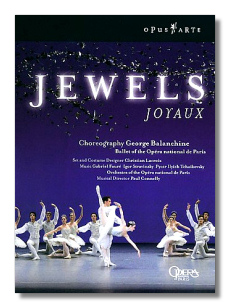
The Internet's Premier Classical Music Source
Related Links
- Latest Reviews
- More Reviews
-
By Composer
-
Collections
DVD & Blu-ray
Books
Concert Reviews
Articles/Interviews
Software
Audio
Search Amazon
Recommended Links
Site News
 DVD Review
DVD Review
Jewels

"Joyaux"
- Gabriel Fauré: Pelléas et Mélisande, Op. 80: Excerpts
- Igor Stravinsky: Capriccio for Piano & Orchestra
- Piotr Ilyitch Tchaikovsky: Symphony #3 in D Major "Polish", Op. 29: Excerpts
Ballet of the Opéra national de Paris
Orchestra of the Opéra national de Paris/Paul Connelly
Choreography by George Balanchine
Opus Arte DVD OA0951D 152min
George Balanchine, one of the great choreographers of the past century, started his career in ballet as a young dancer in his native Russia, soaking up and participating in the work of the great Marius Petipa. Before he was out of his teens, he was creating dances for others. As he traveled west, eventually reaching the United States in the mid 1930s, his style broadened. He was active in Hollywood and on Broadway, where he incorporated more popular elements into his work. By the time he formed the New York City Ballet, he had acquired expertise in a wide variety of dance traditions. Essentially a neoclassicist, he nevertheless was a man of eclectic tastes and talents. Jewels, which was premièred by the New York City Ballet in 1967, is one of the triumphs of that eclecticism. Inspired by a display in one of New York City's most opulent jewelry stores, the ballet is a collection of three shorter works, each approximately a half-hour in length. Emeralds was influenced by classical French ballet, Rubies by American dance, and Diamonds by the Russian school – Petipa in particular. Each ballet is abstract and plotless, and yet it is not difficult to overlay an imaginary plot over each of them, or at least to view them as different facets of romance. Rubies, for example, seems to deal with a playful, flirtatious, kind of love. Mature love is addressed by Emeralds, and Diamonds addresses love in its most idealized and perfect form, perhaps. The jazzy, Cubist Capriccio for Piano and Orchestra by Stravinsky, a composer Balanchine returned to many times, is used in Rubies. Excerpts from Fauré's Shylock and Pelléas et Mélisande are used in Emeralds. Diamonds uses all but the first movement of Tchaikovsky's Third Symphony ("Polish"). Balanchine's choice of music was both inspired and inspiring.
Jewels more or less "belonged" to the New York City Ballet, with a few exceptions, for many years. In 1974, the Ballet of the Opéra national de Paris added Rubies to its repertoire. In 2000, working with some of Balanchine's original dancers, they mounted the complete Jewels – a "jewel" in their crown, one might say! Five years later, in alliance with The George Balanchine Trust, they were able to record their production for posterity. The present DVD was recorded live in October and November of 2005.
The Ballet of the Opéra national de Paris is one of the world's best companies, and they do not disappoint here. The ensemble work is absolutely incredible in terms of technique, synchronization, and artistic values. Jewels plays to the company's strength of being comfortable with many styles of dancing, from coolly classical to hotly modern. All in all, though, this is a ballet about happiness, and that happiness is reflected in the dancing of everyone on the stage, not just the etoiles. However, speaking of etoiles, this performance features wonderful dancers such as Aurélie Dupont (adorably brash in Rubies), Laëtitia Pujol in Emeralds, and Agnès Letestu in Diamonds. These are some of the most alluring dancers active today, and it is a treat to see them together here, probably having the time of their lives. Christian Lacroix's costumes are attractive and appropriately color-coded, but his set design is dull, except in Diamonds. Paul Connelly conducts the orchestra, whose members play this difficult music very capably. (Kudos to pianist Jean-Yves Sébillotte in the Stravinsky.)
Jewels lasts a little over 90 minutes. The remaining 58 minutes are a documentary called "George Balanchine Forever." Most of the material in this documentary is taken from interviews conducted with individuals associated with the current Parisian production. Enjoyable as this was, I would have preferred more archival material, and to hear from dancers who had been involved in the original production of Jewels, or who knew Balanchine firsthand.
The audio (LPCM stereo or DTS Surround) is excellent on this DVD. I am a little less excited by the quality of the video. I don't know if this is true or not, but it looks as if this production was shot to film, not to video. The widescreen image definitely lacks the crispness and detail one has became used to in recent years. It's not awful, but choreography and dancing of this caliber deserve better.
Copyright © 2006, Raymond Tuttle




















